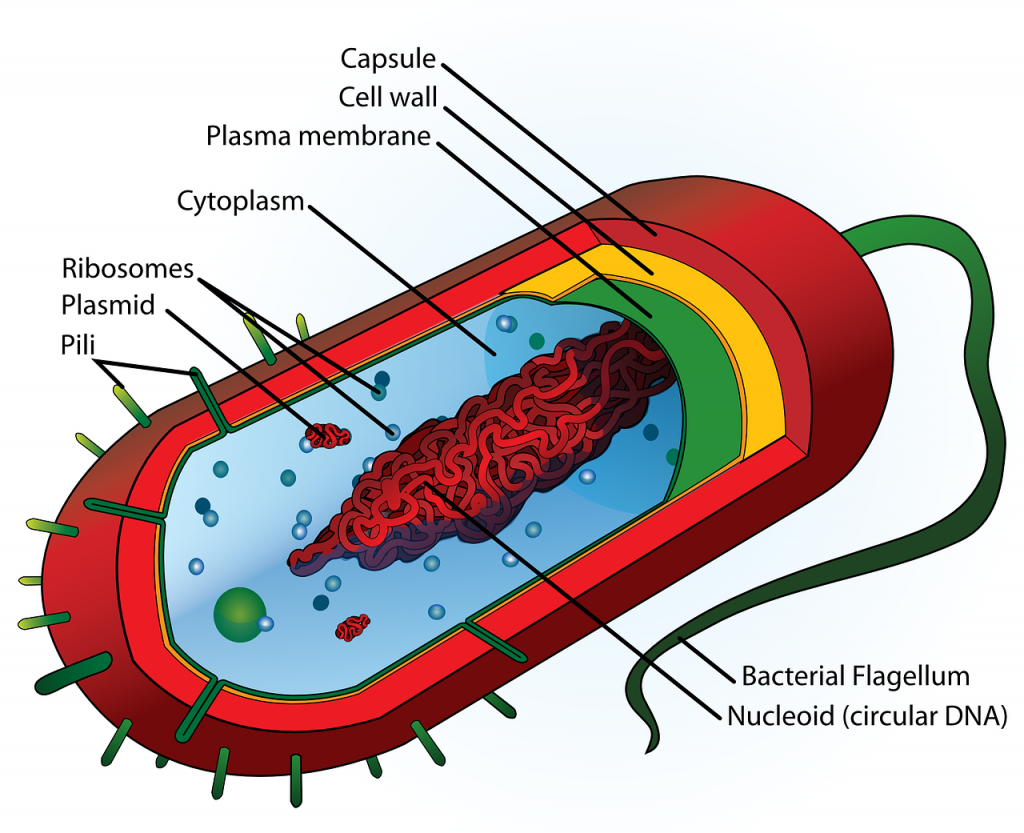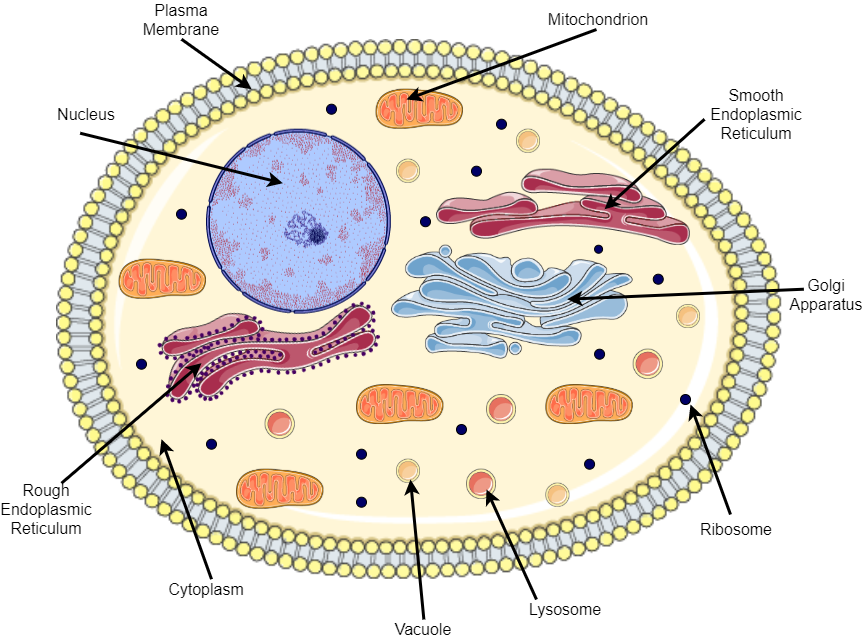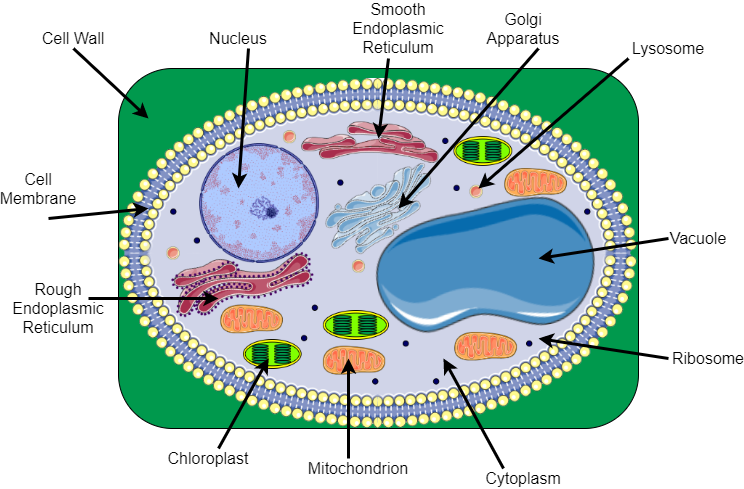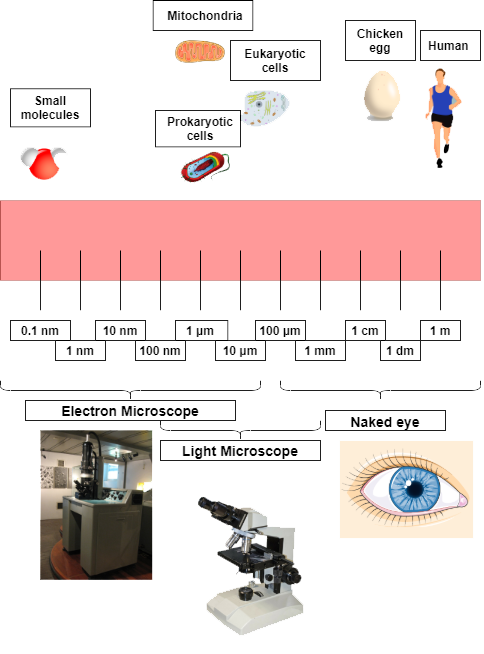We learned previously that the cell is the fundamental structural and functional unit of all the organisms that exist on Earth. Not all of the cells are the same, though. They can be categorized into two groups based on their characteristics, as we will analyze further. These two groups are prokaryotic cells and eukaryotic cells. Consequently, the organisms are called prokaryotes and eukaryotes, respectively.
What do these two names mean?
The word prokaryote comes from the Greek pro, which means before and karyon, which means nucleus (before the nucleus). On the other hand, eukaryote consists of the Greek words eu, which means true and karyon (true nucleus). Therefore, those terms describe the main distinction between the two, referring to the presence or lack of a nucleus. Eukaryotic cells possess a membrane-bound nucleus that stores the DNA, meaning the genetic material. However, prokaryotic cells do not contain a membrane-bound nucleus. Instead, they hold their DNA in a nucleus-like region that’s not surrounded by a membrane, called the nucleoid.
What are the common features between prokaryotic and eukaryotic cells?
Despite their differences, prokaryotic and eukaryotic cells share some similarities, due to their need for carrying out basic functions. These common features include:
- DNA as their genetic material, which stores the cell’s genetic information and determines the organism’s characteristics.
- Cell membrane (also called plasma membrane), a phospholipid bilayer that, as the name suggests, contains phospholipids arranged in a certain way that, along with proteins, form a selective barrier between the inside and outside of the cell. This way, the cell controls what content is exchanged between itself and its environment.
- Cytoplasm, which is a jelly-like fluid that acts as a medium where the biochemical reactions occur. In prokaryotic cells, the cytoplasm comprises everything within the plasma membrane, whereas in eukaryotic cells, we define the cytoplasm as everything between the plasma membrane and the nuclear membrane. The cytoplasm is composed of water, salts, nutrients, proteins, and other compounds. In the case of eukaryotes, it also contains the cell’s organelles, which we will analyze later.
- Ribosomes, machines where protein synthesis takes place.
What are the differences between prokaryotic and eukaryotic cells?
Prokaryotic and eukaryotic cells present many differences that trace back to the way they evolved. Prokaryotic cells are primitive, whereas eukaryotic cells evolved from the first. Consequently, eukaryotic cells developed some features that are absent from prokaryotes. We already talked about their distinction considering the nucleus. Another important difference refers to the presence or absence of intracellular organelles. Organelles are like small organs on the inside of the eukaryotic cell that are enclosed in membranes and are specialized in specific cellular functions.
In prokaryotes, all of the cellular processes occur in the cytoplasm, while in eukaryotes, the compartmentalization of the cytoplasm in organelles allows the division of labor among them. This way, each organelle does its own job in a more efficient way without interfering with other processes. Additionally, the organelles communicate with each other to ensure that every step is carried out and no mistakes take place for the cell’s survival, growth, reproduction, etc.
Prokaryotic cells
Some of the features helping us distinguish prokaryotic from eukaryotic cells are given below:
Nucleoid: the region where the cell’s DNA floats.
Flagella: lash-like structures that protrude from the cell and participate in its movement.
Cell Wall: an additional barrier, surrounding the plasma membrane that provides support and rigidity. Its main ingredient is peptidoglycan.
Pili: hairs attached to cell surface that play a role in the exchange of DNA between cells during cell-cell adhesion.
Plasmids: additional, small, circular DNA molecules that are present in the prokaryotic cell and can replicate independently of the DNA molecule that is located in the nucleoid.

Eukaryotic cells
Some of the basic features of the eukaryotic cells are the following:
Nucleus: The organelle that stores the cell’s DNA. It is surrounded by a lipid bilayer called nuclear envelope. Inside the nucleus, two very important processes take place: DNA replication that ensures that all of the genetic information will be passed on to the daughter cells after cell division and transcription of DNA to RNA, a molecule, which functions as a message that drives protein synthesis.
Mitochondria: It is considered the powerhouse of the cell since it is the location where ATP (energy) is made. Mitochondria also have their own DNA.
Chloroplasts: Organelles that are present in photosynthetic organisms (plants and algae) and are responsible for the photosynthetic process. They absorb the light from the sun and convert it to sugars that can be used by the cell.
Vacuoles: They are membrane-bound organelles, filled with water and various molecules. They can also contain materials that have been engulfed by the cell. Their size and shape change according to their role.
Endoplasmic Reticulum (ER): A network of membranous sacs. There are two types of ER, smooth ER and rough ER. The latter takes its name because of the presence of ribosomes on its membrane, making its appearance granular under the microscope. Some of the important functions of the endoplasmic reticulum are protein synthesis and modification, lipid synthesis, and detoxification.
Golgi Apparatus: It consists of a series of disc-shaped sacs, called cisternae. It packages proteins into vesicles before they are transferred to their destination.
Lysosomes: Vesicles that contain hydrolytic enzymes to digest intracellular molecules.
Cell Wall: An extra layer outside the plasma membrane. Plant cell walls are composed of cellulose. Another group of organisms that present a cell wall is fungi whose cell wall is composed of a different macromolecule called chitin. In both cases, the cell wall provides support and rigidity.

Plant vs animal cells
There are many differences among eukaryotes, even though they all consist of eukaryotic cells. The most familiar eukaryotes are animals and plants. That’s why we list three basic differences between them:
Chloroplasts: Chloroplasts are not present in animal cells, simply because their function is to produce the cell’s food considering plants are autotrophs, while animals consume other organisms to gain the energy and nutrients they need.
Vacuoles: Although animal cells have vacuoles as well, plant cell vacuoles are different. They can digest waste, acting like lysosomes, or store nutrients and water. A single vacuole inside a plant cell can fill up to 90% of the cytoplasm. It plays a very important role in maintaining pressure to allow the cell to resist forces such as the wind’s without losing its form.
Cell Wall: There is no cell wall surrounding the plasma membrane of the animal cells.

Observation of prokaryotic and eukaryotic cells
As we mentioned before, prokaryotic cells appeared first, and it is estimated that they inhabited the Earth about 3.5 to 3.8 billion years ago. Studying the organisms on our planet, we have found that there are two groups of organisms, consisting of prokaryotic cells. These are the famous Bacteria and the, maybe, less known Archaea. Evidence suggests that eukaryotic organisms appeared about 2.7 billion years ago, and it is believed that they formed when a prokaryotic cell engulfed another, giving rise to a eukaryotic cell with membranous organelles on the inside. Organisms that are composed of eukaryotic cells are animals, plants, fungi and protists.
What are the sizes of these cells though? Are the prokaryotic cells bigger or smaller than the eukaryotic ones? Can we see them without aid? With a few exceptions such as chicken eggs, the majority of cells, no matter their structure, function, or origin, is invisible to the naked eye. It is estimated that prokaryotic cells’ diameter ranges from 0.1 to 5.0 μm (micrometers) which is very similar to the size of the mitochondria (0.5 to 1 μm), important organelles of the eukaryotic cells. Therefore, eukaryotic cells, which consist of many organelles, are bigger with their size ranging from 10 to 100 μm. However, the smallest objects the human eye can see without aid are approximately 0.1 millimeters or 100 μm. To put this into perspective, anything smaller than a human hair cannot be distinguished. Consequently, in order to see the cells, we have to use a microscope that magnifies objects. A light microscope lets us see prokaryotic and eukaryotic cells, but if we are interested in observing tiny details, or the internal architecture, including the eukaryotes’ organelles, we definitely need an electron microscope.

from Flickr, under a Creative Commons Attribution-NonCommercial 2.0 Generic License, no changes were made)
